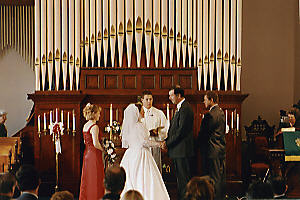 |
|
 |
|
Introduction
So you've been asked, volunteered, persuaded or possibly cornered into shooting a friend's or relative's wedding. Maybe you suspect you will be asked in the near future. Perhaps you're thinking about doing it as a wedding present. Sometimes a local professional isn't available and there isn't enough time to conduct a wider search for one. The national average for a professional wedding photographer is $1,500 after all the prints are ordered. This can vary wildly depending on region and local economics. Not everyone can afford one. It can be one of the significant costs for a wedding, especially in high cost, major metropolitan areas.If you are an avid amateur with single friends or relatives, do reasonably well at the type of photography you normally pursue and don't hide it in a closet, sooner or later you will be asked to shoot a wedding. This tutorial is intended as a Survival Guide for the advanced non-professional who will be shooting a wedding for the first time.
If you're not at least a bit frightened by the prospect of being their "official" wedding photographer, you should be. The sane who understand the task would be terrified. A friend remarked when told I was shooting a wedding, "Are you crazy? A smart amateur photographer would run, not walk, to the nearest Tibetan monastary and hide among the monks until after the wedding!"
If your luck is like mine, your friends and relatives would "rescue" you just before the wedding.
Family members have not spoken to each other for years and long-time friendships have been irretrievably broken over botched attempts at it. Wedding photographs are intended to be treasured for a lifetime. In the early days of photography it's one of the very few times most people ever had a portrait made. It's not simple, it's not for the faint of heart, and it's hard work. It can be a very rewarding experience and a real thrill if it's successful. If shooting a wedding is something you think you want to do, read on. Discover if it's really for you and what it requires to make it successful.
What follows will not teach elementary general photography. Nor is it a tutorial for entering the wedding photography business professionally. It is a Survival Guide for the non-professional and covers topics specific to wedding photography as a very basic primer. It is presumed anyone shooting a wedding for a friend or relative will be an experienced, advanced photographer with a reasonable amount of equipment for the task.
This guide is written from the perspective of someone who has been through what you are contemplating doing. I do professional photography, but not full time. It's a sideline in addition to my "day job." I make no claims at being great. Good . . . maybe . . . but not great. My passion is outdoor landscape, scenic, architectural and fine art. In November 2000 I photographed a relative's wedding and it was my first. Along with being very challenging, it was exciting and enjoyable. None of the photographs in this survival guide were made using anything more than the type of equipment shown and described. A good portion of the photos were test shots to experiment with equipment setups while serving as gaffer and grip to a wedding photographer. After seeing some of my wedding and other work, the professional and close friend who helped me prepare talked me into taking on some of his studio's weddings for him, which I have been doing since my first one.
It would be less than honest if I didn't tell you the amount of gear I use for a professional wedding shoot is considerable, including portable studio lighting, a medium format system in addition to the 35mm, and complete backup for bodies, lenses and flashes. While you won't be able to create some of the special photos a well-equipped and skilled, experienced professional can, you can make excellent, basic wedding photographs with a limited amount of equipment if you know how to use it to get the best performance from it. Well over half the battle is making the right photographs, at the right time, from the right location that allows a good composition, knowing some basics about posing people, and keeping yourself from making technical errors with your equipment.
The first question is whether you have "the right stuff" for it.
=== Back to Top of "Introduction" ===